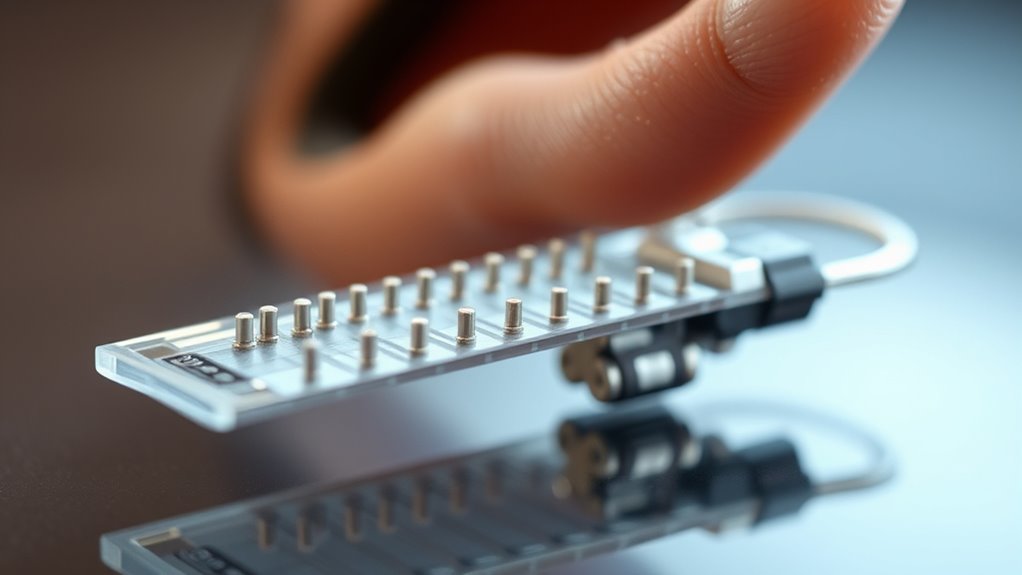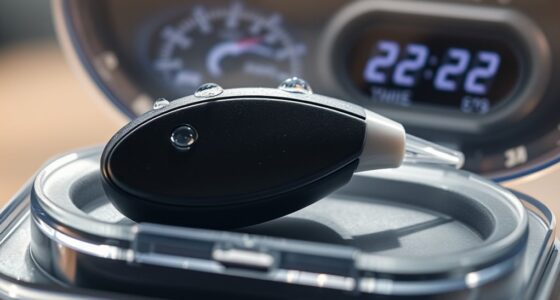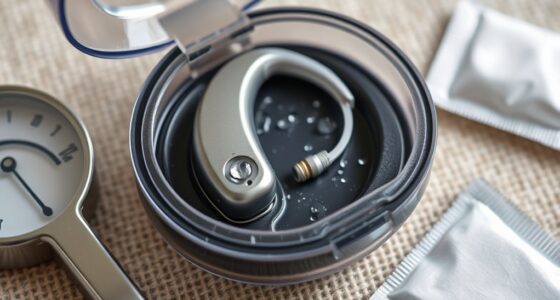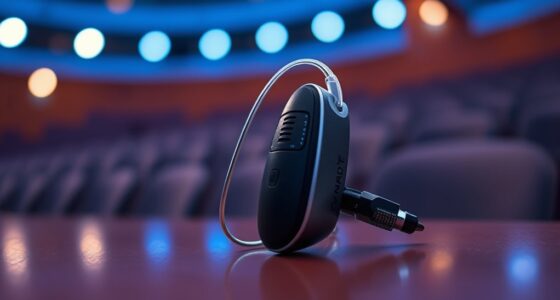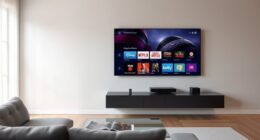Electroacoustic (hybrid) stimulation combines acoustic hearing with cochlear implant technology to help you preserve your natural low-frequency hearing while improving high-frequency sound perception. This personalized setup offers a seamless listening experience, balancing natural sound and amplification. It’s designed to optimize comfort and clarity, adapting to your environment and hearing needs over time. If you’re curious about how it works and what benefits it can bring, there’s more to explore ahead.
Key Takeaways
- Combines acoustic amplification for low frequencies with electric stimulation for high frequencies to improve hearing.
- Preserves residual low-frequency hearing while enhancing high-frequency sound perception.
- Allows personalized device settings to optimize sound quality and speech understanding in various environments.
- Facilitates more natural sound perception, reducing listening fatigue and improving environmental awareness.
- Regular fine-tuning by an audiologist ensures seamless integration and optimal listening experience.
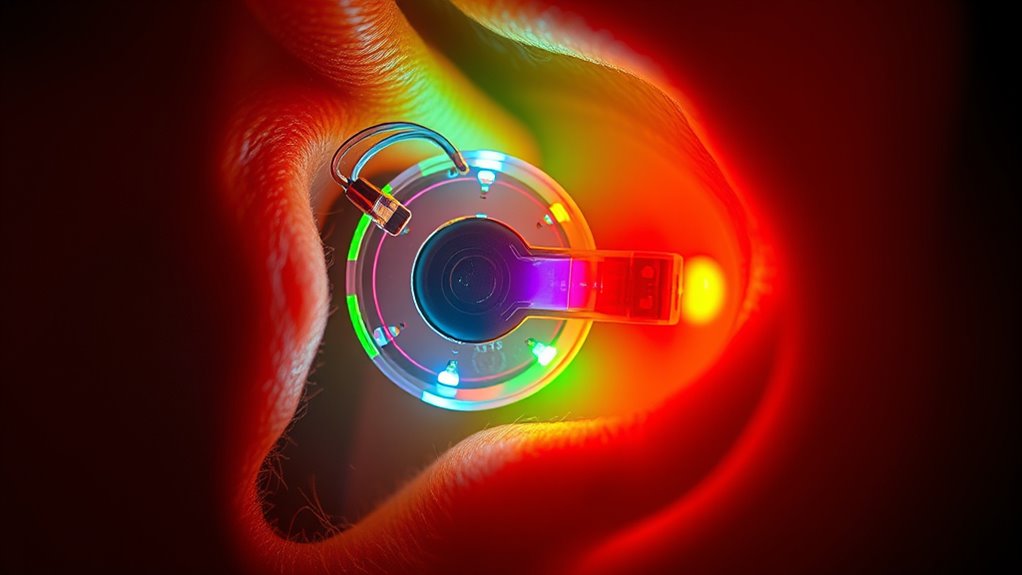
Electroacoustic (Hybrid) Stimulation combines acoustic and electric hearing methods to improve outcomes for individuals with residual low-frequency hearing and high-frequency hearing loss. If you’re considering this approach, you’ll find that it offers a tailored hearing solution that balances natural sound perception with the amplification needed for hearing loss. One of the key aspects is how the device configuration is set up to maximize sound quality, allowing you to enjoy clearer audio across a wide range of environments. The hybrid device typically integrates a hearing aid component for low frequencies and a cochlear implant for high frequencies, providing a seamless experience that mimics natural hearing as much as possible.
Electroacoustic Hybrid Stimulation offers tailored sound solutions by combining acoustic and electric hearing methods for natural, clear audio.
When it comes to sound quality, Hybrid stimulation aims to preserve your residual hearing while enhancing your ability to hear high-frequency sounds, like speech consonants and environmental noises. This dual approach helps you perceive speech more naturally and with less effort. The device configuration plays a crucial role here because it must be precisely tuned to match your unique hearing profile. The programming involves fine adjustments to ensure that the acoustic and electric parts work together smoothly, providing a balanced soundscape. Proper configuration means you’ll notice a more natural sound quality, with clearer speech and better environmental awareness.
The versatility of device configuration also allows for personalized settings. You can have the device calibrated to prioritize certain sounds or environments, making your listening experience more comfortable and effective. For example, if you’re in a noisy place, the device can be adjusted to emphasize speech clarity, reducing background noise. On the other hand, in quieter settings, it can be optimized to deliver more natural, full-spectrum sound. This adaptability ensures that you’re not just getting a generic solution but one that fits your specific hearing needs and lifestyle.
Moreover, the device configuration influences the overall user experience. An optimized setup minimizes sound distortion and feedback, making sounds feel more natural and less artificial. It also helps prevent listening fatigue, which can occur if sounds are poorly balanced or overly processed. The ability to fine-tune the device means you can enjoy better sound quality over time as your hearing needs evolve. Regular adjustments with your audiologist can refine the configuration, ensuring that your Hybrid hearing experience remains ideal. Additionally, understanding the benefits of water-friendly features can help you maintain your device and enjoy aquatic activities safely.
Frequently Asked Questions
How Does Hybrid Stimulation Differ From Traditional Cochlear Implants?
You’ll find that hybrid stimulation differs from traditional cochlear implants mainly in electrode configuration and sound processing algorithms. Hybrid devices combine acoustic amplification for low frequencies with electrical stimulation for high frequencies, allowing you to preserve natural hearing. This approach uses specialized sound processing algorithms that blend acoustic and electric signals seamlessly, giving you a richer, more natural sound experience compared to traditional implants, which rely solely on electrical stimulation.
What Are the Eligibility Criteria for Hybrid Stimulation?
Think of eligibility as planting a seed. If you’re between 18 and 65, you’re the right candidate age, ready to grow. You also need some residual hearing, like a faint melody, that can be enhanced with hybrid stimulation. If your hearing loss isn’t too severe and you still hear some sounds, you’re more likely to qualify. Your audiologist will assess these factors to decide if this treatment suits you.
Can Hybrid Stimulation Improve Hearing in Noisy Environments?
Yes, hybrid stimulation can improve your hearing in noisy environments. It combines acoustic and electric sound processing, enhancing sound quality and helping you better distinguish speech from environmental noise. This technology allows you to enjoy clearer conversations even when background noise is present. By providing a more natural listening experience, hybrid stimulation helps you stay connected and comfortable in challenging auditory settings.
What Are Common Side Effects of Hybrid Stimulation?
Like a fragile glass, hybrid stimulation devices can sometimes crack under pressure. You might experience side effects such as dizziness, balance issues, or occasional device malfunction. These effects are usually temporary and manageable with medical guidance. If you notice persistent problems, it’s crucial to consult your audiologist to make sure your device functions properly and to address any discomfort, helping you regain stability and confidence in your hearing experience.
How Long Does It Take to Adapt to Hybrid Hearing Devices?
You can usually expect an adjustment period of a few weeks to a few months when adapting to hybrid hearing devices. During this device acclimatization stage, your brain learns to interpret new sounds, which can take time. Be patient and consistent with wearing your device daily. If you experience prolonged difficulty or discomfort, consult your audiologist to guarantee proper fit and settings, helping you achieve ideal hearing performance.
Conclusion
Now that you’ve uncovered the magic behind electroacoustic (hybrid) stimulation, you’re like a navigator charting a course through uncharted waters. This innovative approach blends the old and new, creating a symphony where your hearing journey becomes richer and more vibrant. Think of it as tuning a finely crafted instrument, where every note counts. Embrace this cutting-edge technology, and let your world burst into clarity, turning every sound into a masterpiece waiting to be explored.

